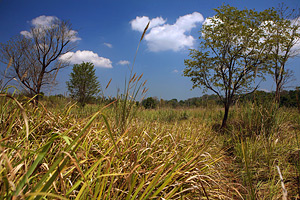|
Protected areas > Thung Yai Naresuan
Wildlife Sanctuary
 |
Savannah of Thung Yai
East
|
 |
Tiger Cave
|
 |
| Dracontomelum mangiferum |
| |
 |
Morning mist
|
Combined with the adjoining
Huai Kha Khaeng Wildlife Sanctuary, Thung
Yai Naresuan forms the largest protected area in mainland South-East Asia,
covering in total 622,200 ha. Although the two sanctuaries are
administered separately, they are essentially a single conservation area.
Both of them were declared a World Heritage Site by the United Nations in
1991.
History
King Naresuan of Ayutthaya twice made bases in this area (in 1590 and 1605)
to prepare for an invasion of Burma. Later this site was called Thung Yai
Naresuan, which means great grassland of Naresuan.
The area has been relatively uninhabited. The forested hills are unsuitable
for farming and the area is still malaria-infested. This prevented the
environment from being changed much by humans and therefore kept it in its
natural condition. Because of that, most of the wild animals typically found
in forested areas in South East Asia have been seen in this area, including
some rare ones such as tigers.
The sanctuary was created on April 24, 1974.
Climate
The wildlife sanctuary's climatic zone belongs to the tropical zone or
subtropics due to its height. The average temperature is between 15-35 C in summer, 20-33
C in the rainy season, and 10-29 C in the
dry season. It has annual rainfall of 2000 mm.
Geography
Thung Yai-Huai Kha Khaeng has some important wetland sites, riverine forests,
small
lakes, ponds, and swamps.
Flora
The principal vegetation types in Thung Yai are hill evergreen forests
(54,900ha), dry evergreen forests (112,900ha), mixed deciduous forest
(164,100ha) and dry dipterocarp forest (3,600ha), savanna forest (9,900ha),
grassland (3,900ha) and areas of swidden agriculture (15,400ha).
Fauna
The fauna of Thung Yai includes some 120 mammals, 400 birds, 96 reptiles, 43
amphibians and 113 freshwater fish. Some more species are suspected as being
present but not confirmed. The sanctuary is big enough to support space for
several large mammals, which are rare or absent now in most areas of
Thailand. Tiger, leopard, clouded leopard, asiatic elephant, tapir, Sumatran
rhinoceros, gaur, mainland serow and hog deer are found here. In 1985 a herd
of 50 gaur was seen, the largest herd recorded in Thailand. Neither banteng,
nor wild water buffalo are confirmed for the area, although both species
live in the neighbouring Huai Kha Khaeng Wildlife Sanctuary. A track of the
The Javan rhinoceros, which is said to have existed in the area was
photographed in 1988.
What to See and Do
The 2km natural trail at the headquarters of the east part of this World
Heritage site will give you an impression of the vegetation of the
sanctuary.
Accommodation
East - camp site is available at the headquarters of Thung Yai East.
Transport
East - 50 km from Um Phang (Tak province) on tour or by car along a partly paved road number 1090. 4WD is not necessary.
Access to the wildlife sanctuary
Thung Yai Naresuan is a wildlife sanctuary, which is much more strictly
protected area than a national park. Wildlife sanctuaries are designated to
allow as free and undisturbed movement of animals as possible. Therefore
they are open mainly for educational or scientific research or for
volunteering. Special permit is necessary to enter a wildlife sanctuary.
More information
For more detailed information on Thung Yai Naresuan see the
United Nations Environment Programme page. |